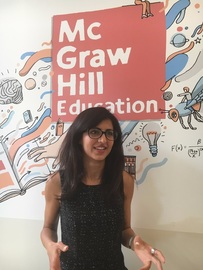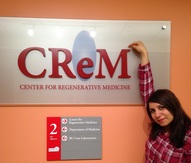|
By Sadaf Atarod
Disclaimer: views expressed herein are those of Dr. Mojarad and do not necessarily reflect the views of the author, the editorial staff, or The Scientista Foundation. Advancements in STEM have created a vast array of career opportunities. Traditional career paths where one works for 20 years in the same company, retiring with a glow of loyalty and a retirement check, are lesser heard of these days. The Y-Generation is more enticed by riskier job offers and is ready to hunt down careers that are new, unique, and have less-defined hierarchical growth paths. As a scientist in the life sciences, I am always curious to find how I can shape my career into one that is able to meet my scientific aspirations, personality, and desire to bring out social change, so meeting Dr. Shirin Mojarad, organizer of the Data Scientist Meetup event at McGraw-Hill Education, was a great chance at finding out about one of the most talked-about career paths for scientists. During the networking session, I chatted with Shirin to find out more about what it takes to become a Data Scientist, how one can enter this industry, and what’s actually out there to help individuals interested in this field to develop their skill sets.  Shirin Mojarad at the Data Scientist meetup. Shirin Mojarad at the Data Scientist meetup.
So Shirin, I hear you did your Ph.D. in Electrical Engineering and, right after graduation, moved out of academia. Why didn’t you opt for the safe path of doing a postdoc in your field? Well, Sadaf, I knew academia was not for me, I loved my Ph.D. research, but it didn’t have a real-life application. There was no doubt that our findings would add value to the scientific community, but there would not be a tangible product out there for people to use. I wanted to be part of industry and not solely in research. Was finding a job as a Data Scientist challenging? It was the right time to apply for Data Scientist positions as the field had just kick-started. The first position I was hired for had a job description that covered exactly all the techniques that I had employed for my Ph.D. research. It was at a software company that had their own analytical unit, and so, I was hired as a data mining consultant. In many ways, the secret sauce to getting the position you want is perseverance! At the time when I was applying, I had thought to myself, If I get this, I can get anything else, and so I gave it my best shot! I watched their online videos and also networked my way around by adding a couple of people on LinkedIn.
How is it being a woman in the Data Scientist field? Have you faced any gender-specific challenges? As an individual, I don’t understand the hype around discrimination between men and women. It isn’t a disadvantage being a woman in tech. There is definitely shortage of women in this area, but that isn’t because there is any discrimination against women when candidates are hired. At least, at the McGraw-Hill Education candidates are selected for their caliber and what they can add to the team. What is the daily job of a Data Scientist? Well, I work for the McGraw-Hill Education in Boston. In general, it is—as they say—a “number cruncher” role. As a Senior Data Scientist, I have three main roles: to (1) support the addition of new features for existing products, (2) conduct efficacy studies around products that help students and teachers, and (3) conduct research to add to the knowledge base of existing data science community. Moreover, company culture varies. For instance, Data Scientist positions at the bank may be stressful, with long hours. Our Boston team is very similar to a startup culture. We have flexi-timing, and as long as I deliver my tasks, there isn’t any rigid time schedule. Does your job involve travelling? Most data scientist positions don’t involve much travelling; however, mine does because I need to present my findings. As mentioned earlier, my role has a research element; hence, presentation and publications are equally important as product development. Just like postdoc positions, our roles mandate “Publish or Perish!” How competitive is the Data Science field? According to McKinsey & Company, “There will be a shortage of talent necessary for organizations to take advantage of big data. By 2018, the United States alone could face a shortage of 140,000 to 190,000 people with deep analytical skills, as well as 1.5 million managers and analysts with the know-how to use the analysis of big data to make effective decisions.” It is difficult to find the right talents to fill Data Scientist positions, as the roles are extremely interdisciplinary. So the good news is: once you are in, it is not competitive! What is the growth ladder or path for Data Scientists? Since it is a new field—less than ten years old, the path is not well defined yet. Most Data Scientists become analysts or directors of data science teams. In general, Data Scientists are not considered as having good management skills. What are the skill sets required for entry into this field? Interestingly, all that you need is to prove that you have worked with actual data! There are several ways you can get access to real data, such as via online competitions--Kaggle competitions. There are also freelance data science positions that are mostly paid, too. You need to be good with numbers and open to learning new things, as there is a steep learning curve in this field. In many ways, a Data Scientist is a bit of both a Statistician and a Programmer. Being able to visualize data in different ways is also a good skill. As long as you have basic programming skills, i.e. exposed to one programming language is good enough to enter this field. As Josh Wills, Director of Data Engineering at Slack Technologies, Inc., puts it, “Data scientist is a person who is better at statistics than any software engineer and better at software engineering than any statistician.” Shirin, now tell me more about your Data Science Meetup group. The turnout has been impressive and the presentations very informational. A couple of my friends have been interested in becoming Data Scientists, and so, this resulted in kick-starting this Meetup group in order to help those who want to become scientists learn the basics of data science. Our goal is to help interested individuals learn what it takes to become Data Scientists. In addition, it is a great place to meet and network with team of Data Scientists. Therefore, McGraw-Hill Education is the sponsor of these meetups. We host the events the end of every month. The presentations are broadcasted live and also recorded for later viewing. You can also always get in touch with your queries via twitter (@shirinmojarad) and LinkedIn. If you would like to learn more about Data Science, there are several online courses, such as Coursera’s Data Science Specialization created by Johns Hopkins University. Also, Shirin recommended Elements of Statistical Learning by Friedman, Tibshirani, and Hastie. About Shirin Mojarad Shirin Mojarad, Ph.D. is currently a Data Scientist at McGraw-Hill Education. She was formerly a Senior Analytics Specialist in the Advanced Analytics team at Canadian Imperial Bank of Commerce (CIBC) and a Data Mining Consultant with a leading software company in predictive analytics. She is an expert in navigating and deriving insight from large datasets using data mining techniques. She has wide experience in framing and conducting complex analyses and experiments using large datasets to find trends in diverse data sources and analyze behavioral patterns using advanced statistical modeling and data mining techniques. Shirin received her Ph.D. in Electrical Engineering and her M.Sc. in Communications and Signal Processing from Newcastle University U.K., where she specialized in predictive modeling and artificial neural networks. 
About the Author
Sadaf Atarod is a Postdoctoral Associate at the Ikonomou Lab, in the Center for Regenerative Medicine (CReM), Boston University. She is enjoying her current research, investigating the biomechanical determinants of lung cell fate in pluripotent stem cells. Her research involves using stem cell biology for tissue engineering applications. Above all, she is delighted to have kick-started her career in science as a postdoc at the CReM where she is supported by experts in the field of induced pluripotent stem cells, who are true advocates of the open science movement with a strong mission in “advancing science to heal the world.” Comments? Leave them below!
0 Comments
Your comment will be posted after it is approved.
Leave a Reply. |
CONNECT WITH USSUBSCRIBE |
The Scientista Foundation, Inc. All Rights Reserved © 2011-2021 | Based in NY | [email protected]
The Network for Pre-Professional Women in Science and Engineering
The Scientista Foundation is a registered 501(c)(3) -- Donate!
The Network for Pre-Professional Women in Science and Engineering
The Scientista Foundation is a registered 501(c)(3) -- Donate!


 RSS Feed
RSS Feed